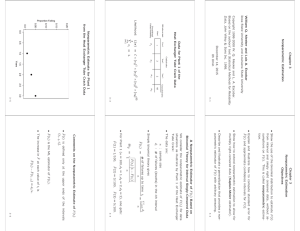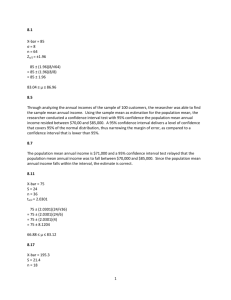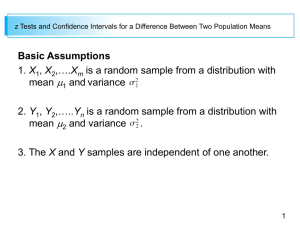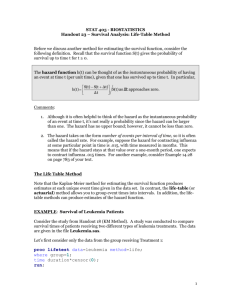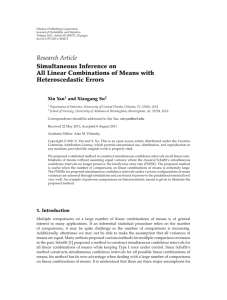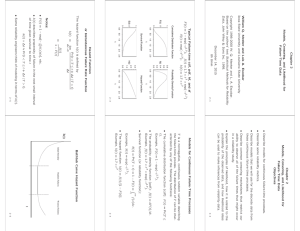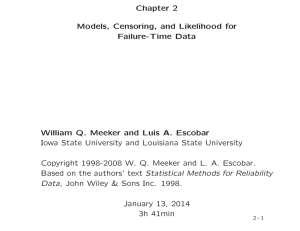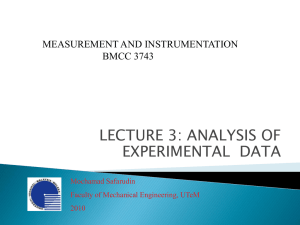Chapter 3 Nonparametric Estimation William Q. Meeker and Luis A. Escobar
advertisement
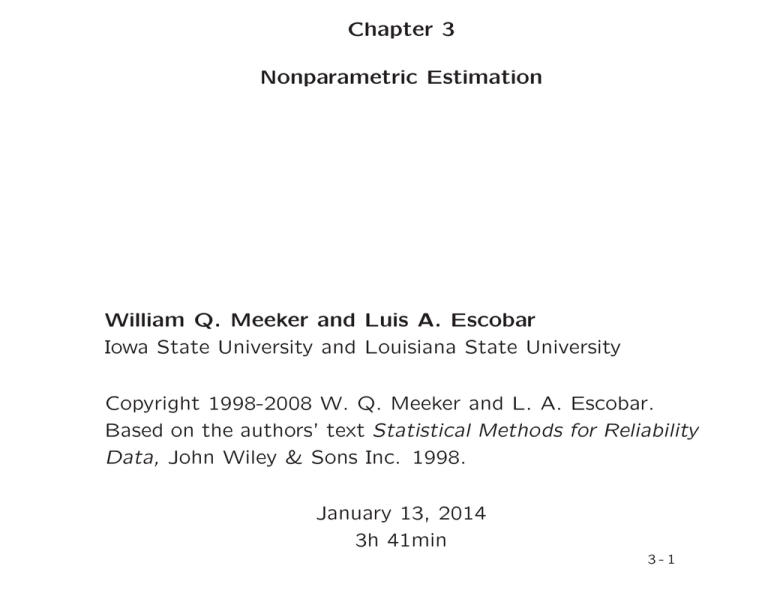
Chapter 3
Nonparametric Estimation
William Q. Meeker and Luis A. Escobar
Iowa State University and Louisiana State University
Copyright 1998-2008 W. Q. Meeker and L. A. Escobar.
Based on the authors’ text Statistical Methods for Reliability
Data, John Wiley & Sons Inc. 1998.
January 13, 2014
3h 41min
3-1
Chapter 3
Nonparametric Estimation
Objectives
• Show the use of the binomial distribution to estimate F (t)
from interval and singly right censored data, without assumptions on F (t). This is called nonparametric estimation.
• Explain and illustrate how to compute standard error for
Fb (t) and approximate confidence intervals for F (t).
• Show how to extend nonparametric estimation to allow for
multiply right-censored data (Kaplan-Meier estimator).
• Describe and illustrate a generalization that provides a nonparametric estimator of F (t) with arbitrary censoring.
3-2
Data for Plant 1 of the
Heat Exchanger Tube Crack Data
Cracked tubes
100 tubes at start
Year 1
Plant 1
Unconditional
Failure Probability
Likelihood:
Year 2
Year 3
1
2
2
π1
π2
π3
Uncracked tubes
95
π4
L(π ) = C × [π1]1 × [π2]2 × [π3]2 × [π4]95
4
X
πi = 1.
i=1
3-3
A Nonparametric Estimator of F (ti) Based on
Binomial Theory for Interval Singly-Censored Data
We consider the nonparametric estimate of F (ti) for data
situations as illustrate by Plant 1 of the Heat Exchanger
Tube Crack:
• The data are:
n : sample size
di : # of failures (deaths) in the ith interval
• Simple binomial theory gives
# of failures up to time ti
b
F (ti) =
=
n
sceFb =
v
h
i
u
u Fb (t ) 1 − Fb (t )
i
i
t
n
Pi
j=1 dj
n
.
• For Plant 1 (n = 100, d1 = 1, d2 = 2, d3 = 2), one gets:
Fb (1) = 1/100,
Fb (2) = 3/100,
Fb (3) = 5/100.
3-4
Nonparametric Estimate for Plant 1
from the Heat Exchanger Tube Crack Data
0.20
Proportion Failing
0.15
0.10
0.05
0.0
0.0
0.5
1.0
1.5
2.0
2.5
3.0
Years
3-5
Comments on the Nonparametric Estimate of F (ti)
• Fb (t) is defined only at the upper ends of the intervals
(ti−1, ti].
• Fb (ti) is the ML estimator of F (ti).
• The increase in Fb at each value of ti is
Fb (ti) − Fb (ti−1) = di/n.
3-6
Confidence Intervals
A point estimate can be misleading. It is important to
quantify uncertainty in point estimates.
• Confidence intervals are very useful in quantifying uncertainty in point estimates due to sampling error arising from
limited sample sizes.
• In general, confidence intervals do not quantify possible deviations arising from incorrectly specified model or model
assumptions.
3-7
Some Characteristic Features of Confidence Intervals
• The level of confidence expresses one’s confidence (not
probability) that a specific interval contains the quantity of
interest.
• The actual coverage probability is the probability that the
procedure will result in an interval containing the quantity
of interest.
• A confidence interval is approximate if the specified level
of confidence is not equal to the actual coverage probability.
• With censored data most confidence intervals are approximate. Better approximations generally require more computations.
3-8
Pointwise Binomial-Based
Confidence Interval for F (ti)
• A 100(1 − α)% conservative confidence interval for F (ti)
based on binomial sampling (see Chapter 6 of Hahn and
Meeker, 1991) is
−1
(n − nFb + 1)F(1−α/2;2n−2nFb+2,2nFb)
F (ti ) =
1+
nFb
e
−1
n − nFb
F̃ (ti ) =
1+
(nFb + 1)F(1−α/2;2nFb+2,2n−2nFb)
where Fb = Fb (ti) and F(1−α/2;ν1,ν2) is the 100(1 − α/2)
quantile of the F distribution with (ν1, ν2) degrees of freedom.
• This confidence interval is conservative in the sense that
the actual coverage probability is at least equal to 1 − α.
3-9
Pointwise Normal-Approximation
Confidence Interval for F (ti)
• For a specified value of ti, an approximate 100(1 − α)%
confidence interval for F (ti) is
[F (ti),
e
F̃ (ti)] = Fb (ti) ± z(1−α/2)sceFb .
where z(1−α/2) is the 1−α/2 quantile of the standard normal
r
h
i
b
b
distribution and sceFb = F (ti) 1 − F (ti) /n is an estimate
of the standard error of Fb (ti).
• This confidence interval is based on
Fb (ti) − F (ti)
∼
˙ NOR(0, 1).
ZFb =
c
seFb
3 - 10
Plant 1 Heat Exchanger Tube Crack Nonparametric
Estimate with Conservative Pointwise 95% Confidence
Intervals Based on Binomial Theory
0.20
Proportion Failing
0.15
0.10
0.05
0.0
0.0
0.5
1.0
1.5
2.0
2.5
3.0
Years
3 - 11
Calculations of the Nonparametric Estimate of F (ti)
for Plant 1 from the Heat Exchanger Tube Crack Data
Year
ti
di
Fb (ti )
bb
se
F
(0 − 1]
1
1
0.01
.00995
95% Confidence Intervals for F (1)
Based on Binomial Theory
˙ NOR(0, 1)
Based on ZFb ∼
(1 − 2]
2
2
0.03
3
2
0.05
[ .0003, .0545 ]
[−.0095, .0295 ]
.01706
95% Confidence Intervals for F (2)
Based on Binomial Theory
˙ NOR(0, 1)
Based on ZFb ∼
(2 − 3]
Pointwise Confidence Interval
F (ti )
F̃ (ti )
e
[ .0062, .0852 ]
[−.0034, .0634 ]
0.02179
95% Confidence Intervals for F (3)
Based on Binomial Theory
Based on ZFb ∼
˙ NOR(0, 1)
[ .0164, .1128 ]
[ .0073, .0927 ]
3 - 12
Integrated Circuit (IC) Failure Times in Hours
Data from Meeker (1987)
.10
1.20
10.00
43.00
94.00
.10
2.50
10.00
48.00
168.00
.15
3.00
12.50
48.00
263.00
.60
4.00
20.00
54.00
593.00
.80
4.00
20.00
74.00
.80
6.00
43.00
84.00
When the test ended at 1370 hours, there were 28
observed failures and 4128 unfailed units.
Note: Ties in the data. Reason?
3 - 13
Nonparametric Estimator of F (t)
Based on Binomial Theory for Exact Failures
and Singly Right Censored Data
When the number of inspections increases the width of the
intervals (ti−1, ti] approaches zero and the failure times are
exact.
• For the integrated circuit life test data, we have: n =
4156 with 28 exact failures in 1370 hours.
For any particular te, 0 < te ≤ 1370, simple binomial theory
gives
# of failures up to time te
b
F (te) =
n
v
h
i
u
u Fb (te ) 1 − Fb (te )
t
.
sceFb =
n
• Methods to obtain confidence intervals for F (te) are the
same as the methods described for the interval data.
3 - 14
Event Plot
Integrated Circuit Life Test Data
Integrated Circuit Failure Data After 1370 Hours
Count
Row
1
2
3
4
5
6
7
8
9
10
11
12
13
14
15
16
17
18
19
20
21
22
2
2
2
2
2
2
2
4128
0
200
400
600
800
1000
1200
1400
Hours
3 - 15
Nonparametric Estimate for the IC Data with Normal
Approximation Pointwise 95% Confidence Intervals
Based on Zlogit(Fb)
0.012
Proportion Failing
0.010
0.008
0.006
0.004
0.002
0.0
0
200
400
600
800
1000
1200
1400
Hours
3 - 16
Comments on the Nonparametric Estimate of F (t)
• Fb (t) is defined for all t in the interval (0, tc] where tc is the
singly censoring time.
• Fb (t) is the ML estimator of F (t).
• The estimate Fb (t) is a step up function with a step of size
1/n at each exact failure time (unless there are ties).
Sometimes the step size is a multiple of 1/n because there
are ties on the failure times.
• When there is no censoring, Fb (t) is the well known empirical
cdf.
3 - 17
Pooling of the Heat Exchanger Tube Crack Data
Plant 1
100
Plant 2
100
Plant 3
99
1
Failure Probability
300
1
99
197
4
5
Uncracked tubes
95
97
5
π2
π1
4
Likelihood:
95
95
3
99
All Plants
2
98
2
100
97
2
2
95
2
95
π3
π4
95
L( π
__) = C [π 1] [π 2] [ π 3] [π4] [π 3+ π 4] [π 2+ π 3+ π 4]
99
3 - 18
A Nonparametric Estimator of F (ti) Based on Interval
Data and Multiple Censoring
The combined data from the heat exchanger tube crack are
multiply censored and the simple binomial method to estimate F (ti) cannot be used.
Here we describe a more general method to compute a nonparametric estimator of F (ti).
where
b )
Fb (ti) = 1 − S(t
i
b ) =
S(t
i
i h
Y
j=1
1 − pbj
i
with
pbj =
dj
nj
n
:
sample size
di
:
# of failures (deaths) in the ith interval
ni = n −
ri
:
i−1
X
j=0
dj −
i−1
X
rj , the risk set at ti−1
j=0
# of right censored obs at ti
3 - 19
Calculations of the Nonparametric Estimate of F (ti)
for the Poooled Heat Exchanger Tube Crack Data
99
pbi
4/300
1 − pbi
296/300
b )
S(t
i
.9867
.0133
5
95
5/197
192/197
.9616
.0384
2
95
2/97
95/97
.9418
.0582
Year
ti
ni
di
ri
(0 − 1]
1
300
4
(1 − 2]
2
197
(2 − 3]
3
97
Fb (ti)
3 - 20
Nonparametric Estimate
for the Heat Exchanger Tube Crack Data
0.20
Proportion Failing
0.15
0.10
0.05
0.0
0.0
0.5
1.0
1.5
2.0
2.5
3.0
Years
3 - 21
Approximate Variance of Fb (ti)
h
i
Qi
b
b
b
• Recall, F (ti) = 1 − S(ti) and S(ti) = j=1 1 − pbj .
i
i
h
h
b
b
• Then Var F (ti) = Var S(ti) .
b ) is
• A Taylor series first-order approximation of S(t
i
i
X ∂S b ) ≈ S(t ) +
qbj − qj
S(t
i
i
j=1 ∂qj qj
where qj = 1 − pj .
• Then it follows that
h
i
b ) ≈ S 2(t )
Var S(t
i
i
i
X
pj
.
n
(1
−
p
)
j
j=1 j
3 - 22
Estimating the Standard Error of Fb (ti)
• Using the variance formula, one gets
h
i
h
i
d S(t
d Fb (t ) = Var
b ) =S
b2(t )
Var
i
i
i
i
X
pbj
b
j=1 nj (1 − pj )
which is known as Greenwood’s formula.
• An estimate of the standard error, seFb , is
sceFb =
r
v
u
i
uX
i
h
pbj
u
d
b
b
Var F (ti) = S(ti) t
.
b
j=1 nj (1 − pj )
3 - 23
Pointwise Normal-Approximation Confidence
Interval for F (ti)-Based on Logit Transformation
• Generally better confidence intervals can be obtained by
using the logit transformation (logit(p) = log[p/(1 − p)])
and basing the confidence intervals on
logit[Fb (ti)] − logit[F (ti)]
∼
˙ NOR(0, 1).
Zlogit(Fb) =
c
selogit(Fb)
• A pointwise normal-approximation 100(1 − α)% confidence
interval for logit[F (ti)] is
"
logit(Fb ),
e
˜ Fb )
logit(
#
= logit(Fb ) ± z(1−α/2)scelogit(Fb)
= logit(Fb ) ± z(1−α/2)sceFb /[Fb (1 − Fb )]
since scelogit(Fb) = sceFb /[Fb (1 − Fb )].
3 - 24
Pointwise Normal-Approximation Confidence
Interval for F (ti)-Based on Logit Transformation
• The confidence interval for F (ti) is obtained from the interval for logit(F ) and using the inverse logit transformation
logit−1(v) =
• Then
[F (ti),
e
1
1 + exp(−v)
F̃ (ti)] = logit−1 logit(Fb ) ± z(1−α/2)scelogit(Fb)
=
=
1
1 + exp −logit(Fb ) ∓ z(1−α/2)scelogit(Fb)
"
Fb
Fb + (1 − Fb ) × w
,
where w = exp{z(1−α/2)sceFb /[Fb (1 − Fb )]}.
Fb
Fb + (1 − Fb )/w
#
• The endpoints F (ti) and F̃ (ti) will always lie between 0 and 1.
e
3 - 25
Normal-Approximation Pointwise Confidence Intervals
for the Heat Exchanger Tube Crack Data
• Computation of standard errors
h
i
h
i
d Fb (t )
Var
i
d Fb (t )
Var
1
= Sb2(ti)
d Fb (t )
Var
2
i
pbj
b
j=1 nj (1 − pj )
= (.9867)2
sceFb(t ) =
1
h
i
X
√
sceFb(t ) =
2
#
.0133
= .0000438
300(.9867)
.0000438 = .00662
= (.9616)2
√
"
"
#
.0254
.0133
+
= .0001639
300(.9867)
197(.9746)
.0001639 = .0128
3 - 26
Normal-Approximation Pointwise Confidence Intervals
for the Heat Exchanger Tube Crack Data
Computation of approximate 95% confidence intervals:
bb =
• For F (1) with Fb (t1) = .0133, se
F (t1 )
√
.0000438 = .00662
bb∼
Based on: ZFb = [Fb (t1) − F (t1)]/se
˙ NOR(0, 1).
F
[F (t1), F̃ (t1)] = .0133 ± 1.96(.00662) = [.0003, .0263].
e
b
Based on: Zlogit(Fb) = [logit[Fb (t1)] − logit[F (t1)]/se
˙ NOR(0, 1).
b) ∼
logit(F
.0133
.0133
,
= [.0050, .035
[F (t1), F̃ (t1)] =
.0133
+
(1
−
.0133)
×
w
.0133
+
(1
−
.0133)/w
e
w = exp{1.96(.00662)/[.0133(1 − .0133)]} = 2.687816.
bb =
• For F (2) with Fb (t2) = .0384, se
F (t2 )
Based on: ZFb,
√
.0001639 = .0128
[F (t2), F̃ (t2)] = [.0133, .0635].
e
Based on: Zlogit(Fb) ,
[F (t2), F̃ (t2)] = [.0198, .0730] .
e
3 - 27
Results of Calculations for Nonparametric Pointwise Confidence Intervals for F (ti) for the Heat Exchanger Tube
Crack Data
Year
ti
(0 − 1]
1
Fb (ti )
.0133
bb
se
F
.00662
95% Confidence Intervals for F (1)
Based on Zlogit(Fb) ∼
˙ NOR(0, 1)
˙ NOR(0, 1)
Based on ZFb ∼
(1 − 2]
2
.0384
3
.0582
[.0050, .0350]
[.0003, .0263]
.0128
95% Confidence Intervals for F (2)
Based on Zlogit(Fb) ∼
˙ NOR(0, 1)
˙ NOR(0, 1)
Based on ZFb ∼
(2 − 3]
Pointwise Confidence Intervals
[.0198, .0730]
[.0133, .0635]
.0187
95% Confidence Intervals for F (3)
Based on Zlogit(Fb) ∼
˙ NOR(0, 1)
˙ NOR(0, 1)
Based on ZFb ∼
[.0307, .1076]
[.0216, .0949]
3 - 28
Heat Exchanger Tube Crack Nonparametric Estimate
with Pointwise 95% Confidence Intervals
Based on Zlogit(Fb)
0.20
Proportion Failing
0.15
0.10
0.05
0.0
0.0
0.5
1.0
1.5
2.0
2.5
3.0
Years
3 - 29
Shock Absorber Failure Data
First reported in O’Connor (1985).
• Failure times, in number of kilometers of use, of vehicle
shock absorbers.
• Two failure modes, denoted by M1 and M2.
• One might be interested in the distribution of time to failure for mode M1, mode M2, or in the overall failure-time
distribution of the part.
Here we do not differentiate between modes M1 and M2.
We will estimate the distribution of time to failure by either
mode M1 or M2.
3 - 30
Failure Pattern in the Shock Absorber Data
Failure Mode Ignored
(O’Connor 1985)
ShockAbsorber Data (Both Failure Modes)
Row
1
2
3
4
5
6
7
8
9
10
11
12
13
14
15
16
17
18
19
20
21
22
23
24
25
26
27
28
29
30
31
32
33
34
35
36
37
38
0
5000
10000
15000
20000
25000
30000
Kilometers
3 - 31
Nonparametric Estimation of F (t) with Exact Failures
(Kaplan-Meier) Estimator
In the limit, as the number of inspections increases and the
width of the inspection intervals approaches zero, we get
the product-limit or Kaplan-Meier estimator:
• Failures are concentrated in a small number of intervals of
infinitesimal length.
• Fb (t) will be constant over all intervals that have no failures.
• Fb (t) is a step function with jumps at each reported failure
time.
Note: The binomial estimator for exact failures and singly
right censored data is a special case of the Kaplan-Meier
estimate.
3 - 32
Nonparametric Estimates for the Shock Absorber Data
up to 12,220 km
Conditional
tj (km)
nj
dj
rj
6,700
6,950
7,820
8,790
9,120
9,660
9,820
11,310
11,690
11,850
11,880
12,140
12,200
...
38
37
36
35
34
33
32
31
30
29
28
27
26
...
1
0
0
0
1
0
0
0
0
0
0
0
1
...
0
1
1
1
0
1
1
1
1
1
1
1
0
...
Unconditional
pbj
1/38
1 − pbj
37/38
b
S(t
j)
Fb (tj )
0.97368
0.02632
1/34
33/34
0.94505
0.05495
1/26
...
25/26
...
0.90870
...
0.09130
...
3 - 33
Nonparametric Estimate for Shock Absorber Data with
Pointwise 95% Confidence Intervals Based on Zlogit(Fb)
1.0
Proportion Failing
0.8
0.6
0.4
0.2
0.0
0
5000
10000
15000
20000
25000
Kilometers
3 - 34
Nonparametric Estimate for Shock Absorber Data with
Simultaneous 95% Confidence Bands Based on Zlogit(Fb)
1.0
Proportion Failing
0.8
0.6
0.4
0.2
0.0
0
5000
10000
15000
20000
25000
Kilometers
3 - 35
Need for Nonparametric Simultaneous
Confidence Bands for F (t)
• Pointwise confidence intervals for F (t) are useful for
making a statement about F (t) at one particular value of t.
• Simultaneous confidence bands for F (t) are necessary to
quantify the sampling uncertainty over a range of values
of t.
3 - 36
Nonparametric Simultaneous Confidence Bands
for F (t)
Approximate 100(1 − α)% simultaneous confidence bands for
F can be obtained from
F (t), F̃ (t) = Fb (t)±e(a,b,1−α/2)sceFb (t) for all t ∈ [tL(a), tU (b)]
e
where [tL(a), tU (b)] is a complicated function of the censoring
pattern in the data.
Comments:
• The approximate factors e(a,b,1−α/2) can be computed from
a large-sample approximation given in Nair (1984).
• e(a,b,1−α/2) is the same for all values of t.
• The factors e(a,b,1−α/2) are greater than the corresponding
z(1−α/2).
3 - 37
Factors e(a,b,1−α/2) for Computing the EP
Nonparametric Simultaneous
Approximate Confidence Bands
Limits
a
b
.005 .999
.01
.999
.05
.999
.001 .995
.005 .995
.01
.995
.05
.995
.001 .99
.005 .99
.01
.99
.05
.99
.001 .95
.005 .95
.01
.95
.05
.95
.001 .9
.005 .9
.01
.9
.05
.9
Confidence Level
.80
.90
.95
.99
2.92 3.17 3.41 3.88
2.90 3.15 3.39 3.87
2.84 3.10 3.34 3.82
2.92 3.17 3.41 3.88
2.86 3.12 3.36 3.85
2.84 3.10 3.34 3.83
2.76 3.03 3.28 3.77
2.90 3.15 3.39 3.87
2.84 3.10 3.34 3.83
2.81 3.07 3.31 3.81
2.73 3.00 3.25 3.75
2.84 3.10 3.34 3.82
2.76 3.03 3.28 3.77
2.73 3.00 3.25 3.75
2.62 2.91 3.16 3.68
2.80 3.07 3.31 3.80
2.72 3.00 3.25 3.75
2.68 2.96 3.21 3.72
2.56 2.85 3.11 3.64
3 - 38
Nonparametric Estimate Heat Exchanger Tube Crack
Data with Simultaneous 95% Confidence Bands
Based on Zmax logit(Fb)
0.20
Proportion Failing
0.15
0.10
0.05
0.0
0.0
0.5
1.0
1.5
2.0
2.5
3.0
Years
3 - 39
Better Nonparametric Simultaneous Confidence Bands
for F (t)
• The approximate 100(1−α)% simultaneous confidence bands
b b(t) for all t ∈ [tL(a), tU (b)]
F (t), F̃ (t) = Fb (t) ± e(a,b,1−α/2) se
F
e
are based on the approximate distribution of
b (t) − F (t)
F
max
.
ZmaxFb =
t ∈ [tL(a), tU (b)]
sce b
F (t)
• It is generally better to compute the simultaneous confidence bands based on the logit transformation of Fb . This
gives
"
Fb (t)
Fb (t)
[F (t), F̃ (t)] =
,
b
b
F (t) + [1 − F (t)] × w Fb (t) + [1 − Fb (t)]/w
e
#
b b/[Fb (1 − Fb )]}.
where w = exp{e(a,b,1−α/2)se
F
These are based on the approximate distribution of
#
"
logit[Fb (t)] − logit[F (t)]
max
.
Zmax logit(Fb) =
t ∈ [tL (a), tU (b)]
b
selogit[Fb(t)]
3 - 40
Nonparametric Estimation of F (ti)
with Arbitrary Censoring
• The methods described so far work only for some kinds of
censoring patterns (multiple right censoring, interval censoring with intervals that do not overlap, and some other
very special censoring patterns.)
• The nonparametric maximum likelihood generalizations provided by the Peto/Turnbull estimator can be used for
◮ Arbitrary censoring (e.g., both left and right).
◮ Censoring with overlapping intervals.
◮ Truncated data.
3 - 41
Event Plot
Turbine Wheel Inspection Data
Turbine Wheel Crack Initiation Data
Count
Row
1
2
3
4
5
6
7
8
9
10
11
12
13
14
15
16
17
18
19
20
21
?
?
|
?
|
?
|
?
|
?
|
?
|
?
|
?
|
?
0
39
4
49
2
31
7
66
5
25
9
30
9
33
6
7
22
12
21
19
21
15
|
10
20
|
30
40
50
Hundreds of Hours
3 - 42
Turbine Wheel Inspection Data Summary
100-hours of
Exposure
ti
# Cracked
Left Censored
# Not Cracked
Right Censored
4
10
14
18
22
26
30
34
38
42
46
0
4
2
7
5
9
9
6
22
21
21
39
49
31
66
25
30
33
7
12
19
15
Proportion Cracked
Crude Estimate of
F (t)
0/39 = .000
4/53 = .075
2/33 = .060
7/73 = .096
5/30 = .167
9/39 = .231
9/42 = .214
6/13 = .462
22/34 = .647
21/40 = .525
21/36 = .583
Data from Nelson (1982), page 409.
• The analysts did not know the initiation time for any of the
wheels.
• All they knew about each wheel was its exposure time and
whether a crack had initiated or not. Units grouped by
exposure time.
3 - 43
Plot of Proportions Failing Versus Hours of Exposure
for the Turbine Wheel Inspection Data
Proportion Failing
0.8
0.6
0.4
0.2
0.0
0
10
20
30
40
50
Hundreds of Hours
3 - 44
Basic Parameters Used in Computing the
Nonparametric ML Estimate of F (t) for the Turbine
Wheel Data
0
39
π1
0
4
4
49 2
21 15
31
π 2 π 3 π 4 π 5 π6 π 7 π 8 π 9 π10 π11 π12
10
18
26
34
42 46
Hundreds of Hours
3 - 45
Nonparametric Estimation of F (t) with Arbitrary
Censoring-General Approach
• Basic idea: write the likelihood and maximize this likelib from which one gets Fb (ti) (Peto 1973).
hood to obtain pb or π
• Illustration: the likelihood for the turbine wheel inspection
data is
L(π ) = L(π ; DATA) = C × [π1]0 × [π2 + · · · + π12]39 ×
[π1 + π2]4 × [π3 + · · · + π12]49 ×
[π1 + · · · + π3]2 × [π4 + · · · + π12]31 ×
...
P
[π1 + · · · + π11]21 × [π12]15
where π12 = 1 − 11
i=1 πi . The values of π1 , . . . , π11 that
b , the ML estimator of π . Then
maximize L(π ) gives π
P
Fb (ti) = ij=1 π̂j , i = 1, . . . , m.
3 - 46
Nonparametric ML Estimate for the Turbine Wheel
Data with 95% Pointwise Confidence Intervals for
F (ti) Based on Zlogit(Fb)
0.8
Proportion Failing
0.6
0.4
0.2
0.0
0
10
20
30
40
50
Hundreds of Hours
3 - 47
Other Topics in Chapter 3
• Maximum likelihood methods to compute nonparametric
confidence intervals and confidence bands.
• Uncertain censoring times.
3 - 48
